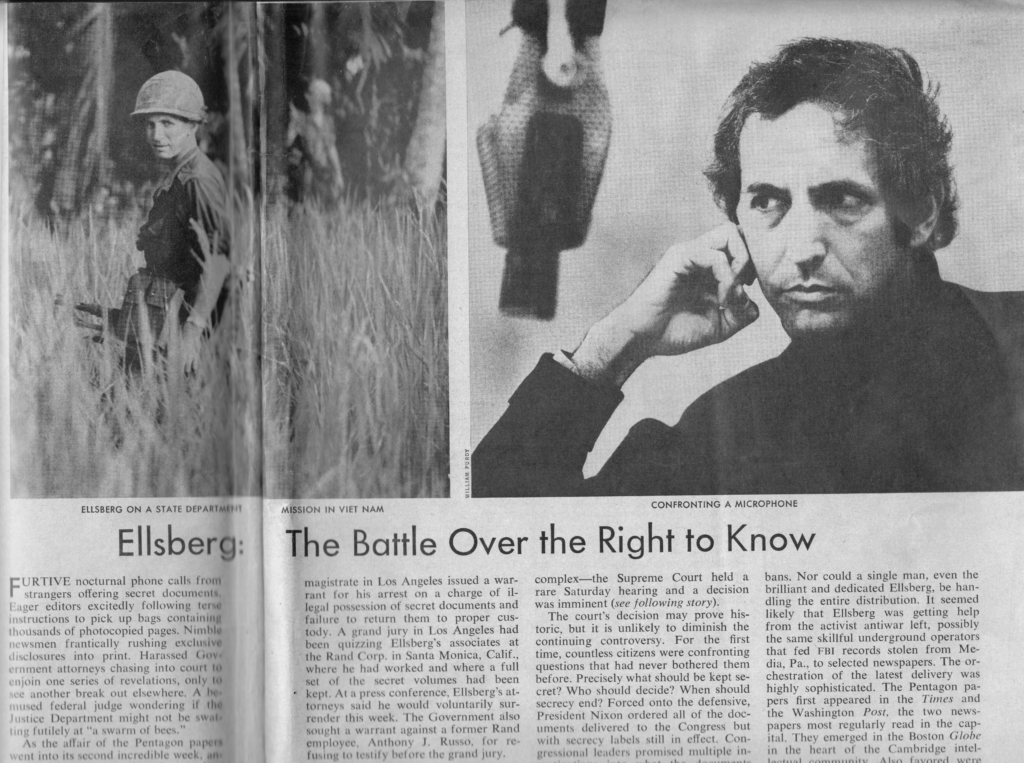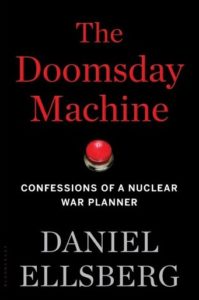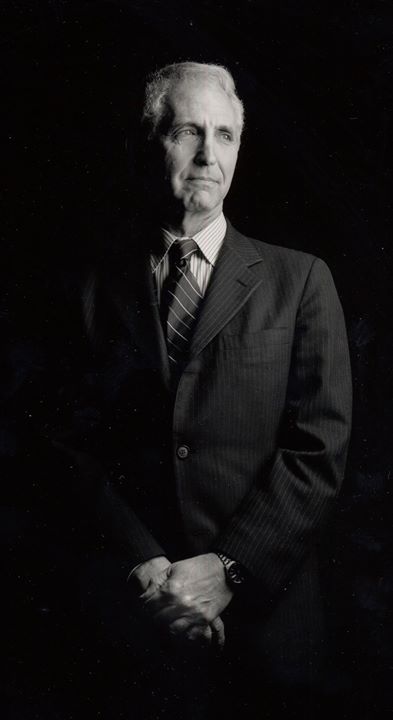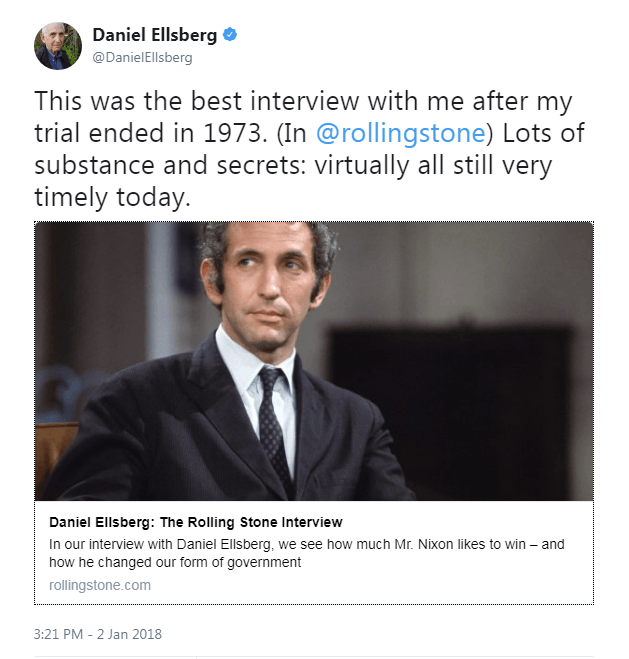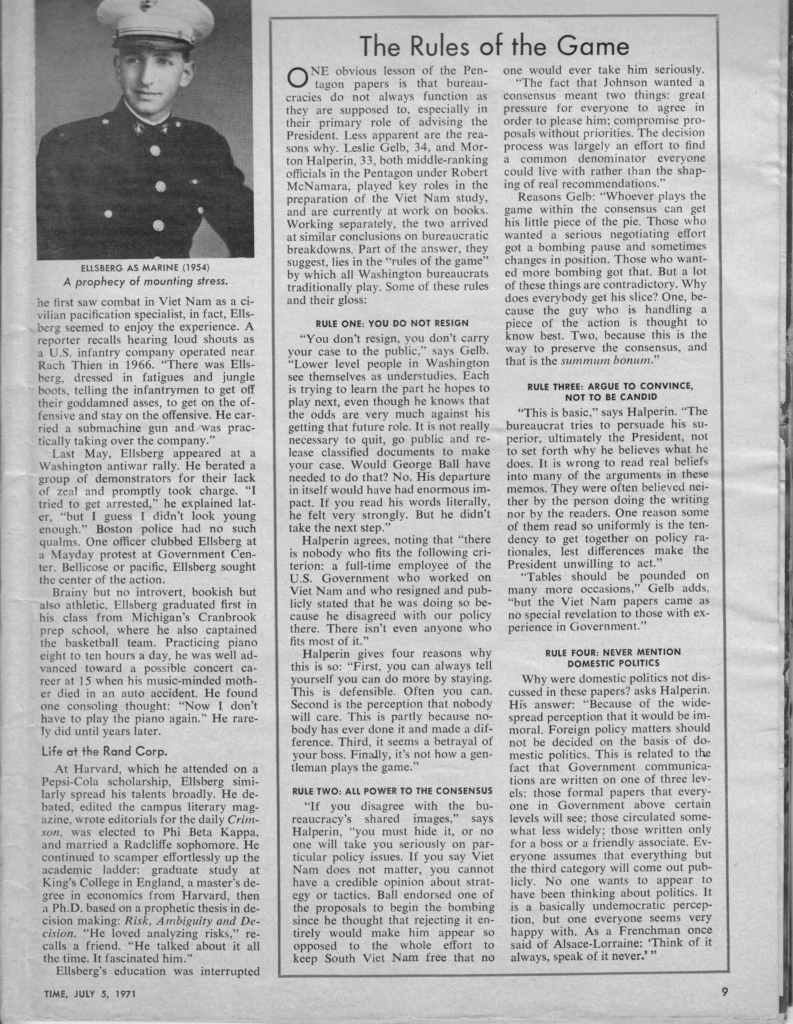Published 2017
Strategic Demands Editor, Steven Schmidt:
It is time to recall my memories of Dan Ellsberg of nearly 50 years ago…
From a nondescript building in Santa Monica to a house on the beach in Malibu, from a basketball court in Pacific Palisades to a Parade editor’s tennis court on Sunset Boulevard…
My recollections are of a scholar and soldier, as Dan changed my life with his intelligence and courage.
I was a student activist who returned from DC and the start up of the Vietnam Moratorium Committee.
It has been many steps on the journey since then and the week before last I looked forward to receiving Dan’s new book. Dan was getting ready for the book launch and author tour and came down with laryngitis. He had to break a dinner engagement to spare his voice and again memories came back of the last days in California and our last meeting as he prepared to release “the papers”.
What Dan was experiencing as we met for the last time at his home in Malibu, surrounded by what was soon to be called “the Pentagon Papers”, was a howl-at-the-moon night. I shared moments as he prepped for leaving for the East Coast to release the documents. I watched bravery in action. I also watched a solitary man who, in the middle of packing papers, went out under the moon into the heavy surf and swam straight out, disappearing.
On shore we waited, literally wondering if he would come back.
He knew and I knew his life would never be the same.
It wasn’t and it hasn’t been since.
His new work, The Doomsday Machine, is now in the third act of this brave man’s life.
He brings a warning again with him. This time the warning cannot be litigated by a president and Supreme Court. This time we must listen.
https://archive.org/details/the-doomsday-machine-confessio-daniel-ellsberg
https://books.google.com/books/about/The_Doomsday_Machine.html?id=I3gvDwAAQBAJ
https://carnegieendowment.org/2018/02/08/doomsday-machine-daniel-ellsberg-s-riveting-memoir-flags-risks-of-nuclear-winter-pub-75496
◊
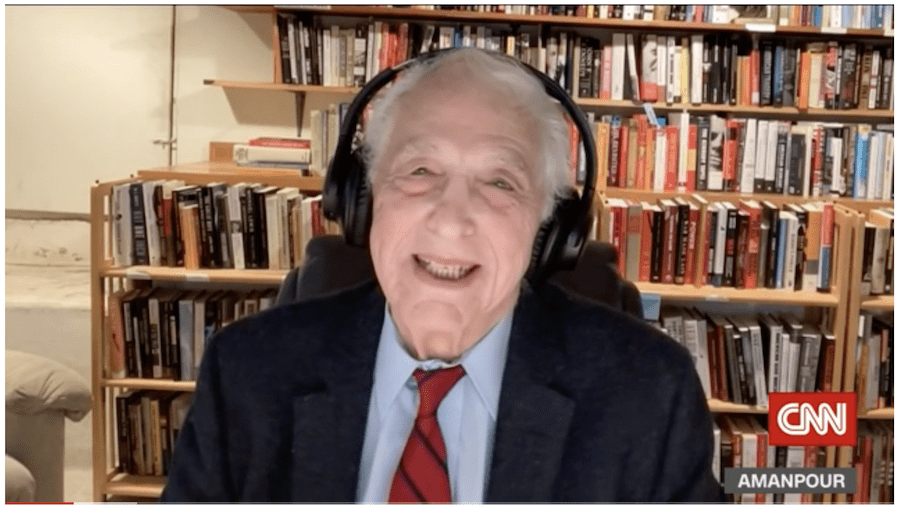
June 2023
In Memory of a Brave Man
Daniel Ellsberg released the revealing history of the Vietnam war, the “Pentagon Papers” for the American people to see and discern the harsh reality of wartime lies and disaster that resulted. His life was that of a patriot who did his best until the end…
On the passing of Daniel Ellsberg (April 7, 1931 – June 16, 2023)
One month ago, StratDem’s editor wrote of a time when, as a young student, I visited my friend, a man named Dan, in his beachfront house as he prepared to leave for the east coast to release what came to be known as the Pentagon Papers…. His deep concerns were evident that night. I only knew part of the story back then. I soon learned I was observing and participating in history…
In Memory of a Man Named Daniel
By Steven Schmidt,
Editor, Strategic Demands
June 17, 2023
The moon was bright that night as I visited Daniel Ellsberg at his house on the beach in Southern California. It was mid 1970 and Dan was surrounded by boxes. “Papers,” he called them. He was packing to leave for Cambridge and a new position at MIT and he was worried that night as he showed me the study he had put together at the Rand Corporation in Santa Monica.
As we sorted through documents I noticed some had Top Secret stamped on some of them. I learned later that these were part of the 7000 page, forty plus volume report soon to be called the “Pentagon Papers.”
Dan spoke of President Nixon and famed advisor, Henry Kissinger with first-hand knowledge. He mentioned he had met with Kissinger recently at Nixon’s San Clemente estate. I remember his fear, both that Nixon and Kissinger were repeating mistakes of previous administrations as “the Papers” demonstrated, and how the truth needed to go public. He broke off from the packing and said let’s go, “I need to swim”.
Dan was depressed, I knew, and I was not going to convince him not to go into the loudly crashing night surf. I watched as he plunged into the waves. He then reappeared for a moment in the moonlight. He swam straight out, then disappeared. I waited on shore looking out at the dark ocean. Time passed, no sign of Dan. I began worrying. Is this the end of Dan Ellsberg? Did I just witness Dan ending it all? Did a riptide take him? I walked up and down the beach searching. Suddenly, Dan walked out of the surf, nodded then sprinted back toward the house. He quickly shifted back into work mode. Something happened, he had new resolve.
Today as I reflect on the life of Dan Ellsberg and the announcement of his death, I can say he lived life like few others. He pursued the truth and facts in a way that was astounding and committed. He went on to prove in his actions that he was brave to put his life on the line for the sake of the American people. His decision was purposeful. He thought deeply about the consequences. That night under the moon I saw his fear, and I saw his resolve.
A few months later, when Daniel released the Pentagon Papers to a NY Times writer, Neil Sheehan, the truth came out. Dan’s history of the war study subsequently led to the end of the Nixon presidency and, as a consequence, the end of the Vietnam War. Dan would later say the Pentagon Papers themselves didn’t directly end the war, but the American people learned of the “evidence of a quarter-century of aggression, broken treaties, deceptions, stolen elections, lies, and murder”. This, with Nixon’s resignation, brought on the end of the war.
I learned over the course of our relationship that Dan Ellsberg was gifted, literally. I still say he is the smartest man I’ve ever known. His 2002 book “Secrets: A Memoir of Vietnam and the Pentagon Papers” is a must read. “On the evening of October 1, 1969, I walked out past the guards’ desk at the Rand Corporation in Santa Monica,” he writes, “carrying a briefcase filled with top secret documents, which I planned to photocopy that night… How I came to do this is the focus of this memoir.” Dan’s memoir is a true American story.
Beyond the Pentagon Papers and resulting demise of the Nixon presidency, Dan Ellsberg’s follow-on 2017 book “The Doomsday Machine: Confessions of a Nuclear War Planner” later explained the inner machinations of the nuclear war complex. He was, as a younger man, a systems man and followed orders. His nuclear war gaming was a Pentagon nuclear plan that he, as an old man, brought into the light with this revelatory book. The extent of humanity’s threat to life on earth is part of Dan Ellsberg’s legacy now.
Daniel Ellsberg’s life is a testament to what generations to come have to deal with — perpetual wars, the realities of nuclear weapons, modern states with awesome powers for good and bad. Dan Ellsberg revealed and pointed us to harsh realities.
Will we listen to Dan Ellsberg’s message that he, risking all, brought to us?
Daniel Ellsberg, after all is said and done, was a man who taught us. He was a man of peace. Dan was a believer in the power each of us has to make a difference and move toward a better world.

Dan Ellsberg and Strategic Demands editor stayed in touch over the years …
In 2023 a PBS / Public Broadcasting documentary interviewed a number of us who were involved in opposition to the Vietnam war and the result was to reveal ‘how close the nation came to nuclear weapons use’.
The Movement and the Madman looked back at how the peace movement, the Vietnam Moratorium and nationwide organizing kept a ‘mad’ decision by Nixon-Kissinger from becoming a reality … and catastrophe.
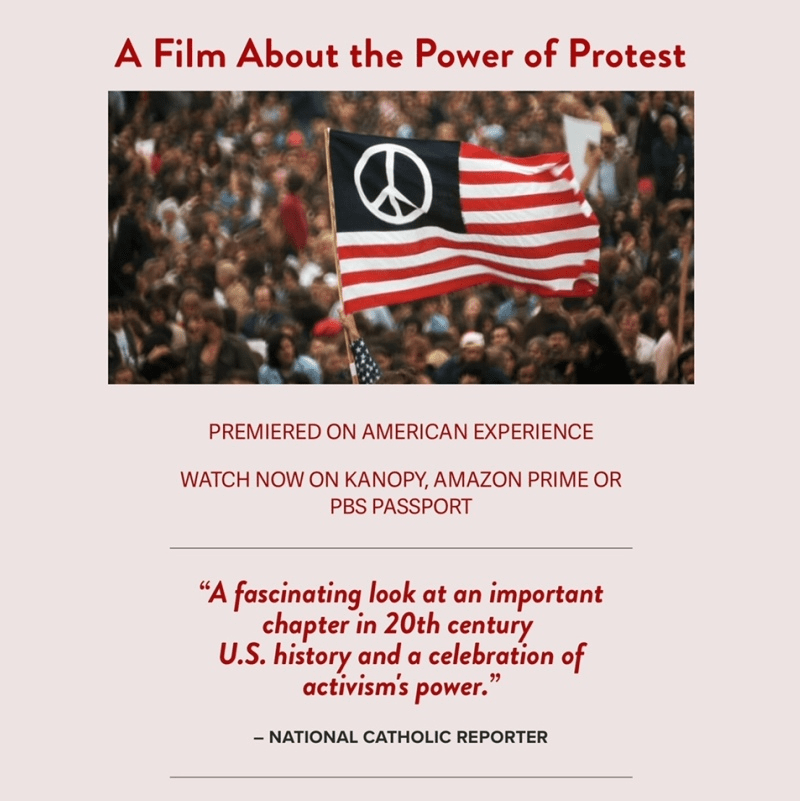
https://strategicdemands.com/the-movement-and-the-madman-1969-near-nuclear-use/
PBS
The Movement and the ‘Madman’: PBS PREMIERE MARCH 28, 2023 ON AMERICAN EXPERIENCE — A nuclear war planner and National Security Policy staff recall how close the US came to using nuclear weapons in Vietnam in 1969
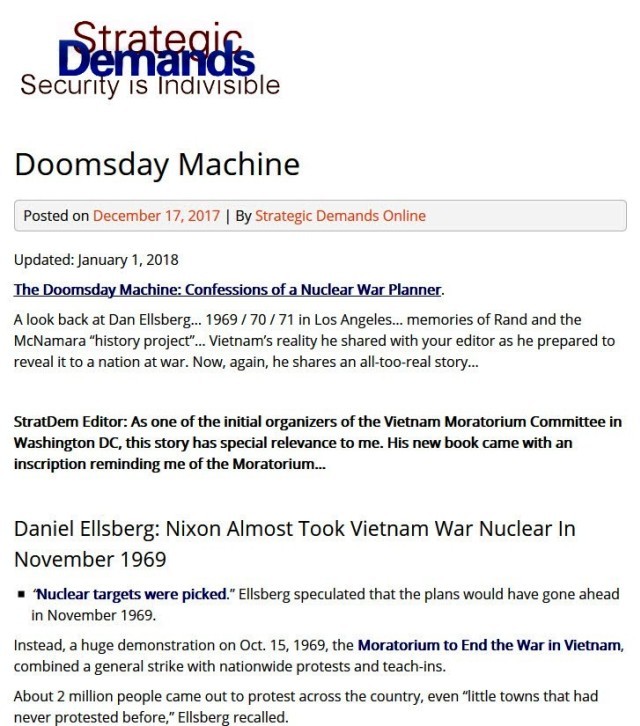
The Movement and Madman documentary film
The little-known story of a dramatic showdown between a protest movement and a president
* https://www.movementandthemadman.com/home
* https://www.movementandthemadman.com/history
* https://www.movementandthemadman.com/preview
* https://www.movementandthemadman.com/interviewees
* https://www.movementandthemadman.com/filmmakers
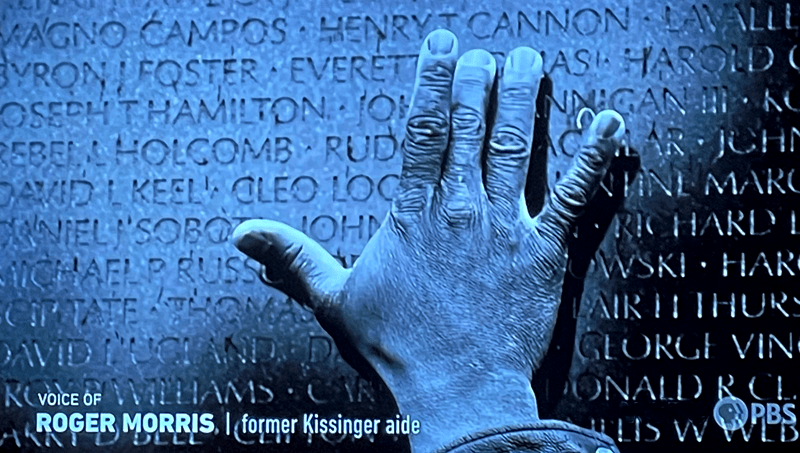
Roger Morris / @Strategic Demands
In the “Doomsday Machine”: Daniel Ellsberg, recalls the Vietnam Moratorium Peace Movement of October – November 1969.
In 2023, as threats to use nuclear weapons resound from Russia during the Ukraine war, in the U.S. PBS filmmakers revisit the threat, not known in 1969, being planned in the White House — and how politics changed a president’s mind.
December 2017
The Doomsday Machine: Confessions of a Nuclear War Planner.
A look back at Dan Ellsberg… 1969 / 70 / 71 in Los Angeles… memories of Rand and the McNamara “history project”… Vietnam’s reality he shared with your editor as he prepared to reveal it to a nation at war. Now, again, he shares an all-too-real story.
StratDem Editor: As one of the initial organizers of the Vietnam Moratorium Committee in Washington DC, this story has special relevance to me. His new book came with an inscription reminding me of the Moratorium…
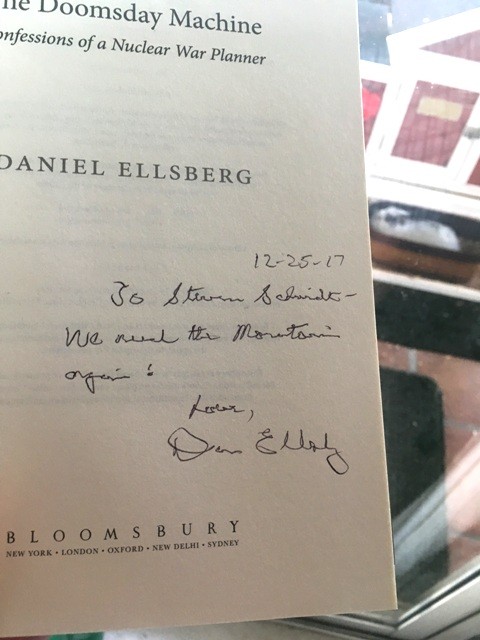
12-25-17
To Steven Schmidt – We need the Moratorium again !
L
Dan Ellsberg
Daniel Ellsberg: Nixon Almost Took Vietnam War Nuclear In November 1969
- “Nuclear targets were picked.” Ellsberg speculated that the plans would have gone ahead in November 1969.
Instead, a huge demonstration on Oct. 15, 1969, the Moratorium to End the War in Vietnam, combined a general strike with nationwide protests and teach-ins.
About 2 million people came out to protest across the country, even “little towns that had never protested before,” Ellsberg recalled.
“Without the Moratorium, there would have been an escalation, possibly the use of nuclear weapons in November 1969.”
Updated: February 26, 2018
Bulletin of the Atomic Scientists
Daniel Ellsberg on the Need for Dismantling the ‘Doomsday Machine’
Question & Answer with John Mecklin, editor-in-chief of the Bulletin of the Atomic Scientists
Dan Ellsberg’s new book speaks to command and control of nuclear weapons
-
http://nymag.com/daily/intelligencer/2017/11/daniel-ellsberg-on-the-doomsday-machine.html
-
http://billmoyers.com/story/ellsberg-upcoming-book-warns-trump-nuclear-dangers/
Permalink
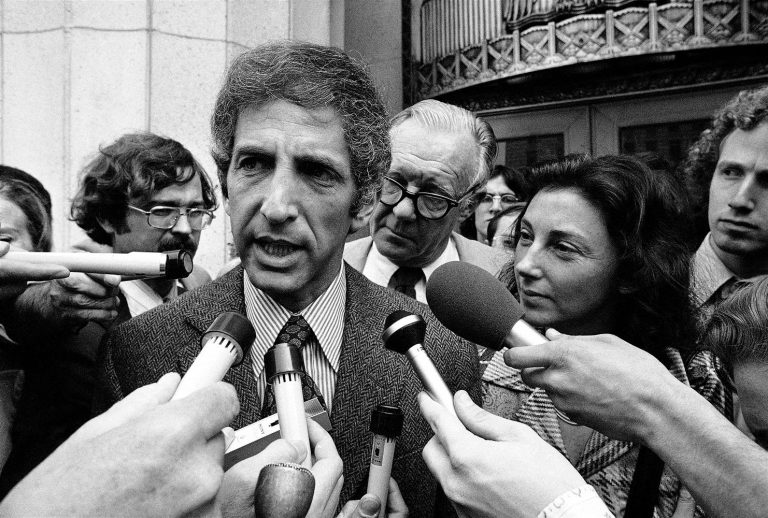
StratDem Editor: Reviewing “The Doomsday Machine”
“This is not a species to be trusted with nuclear weapons…”
Let us begin with a single page from “Doomsday”
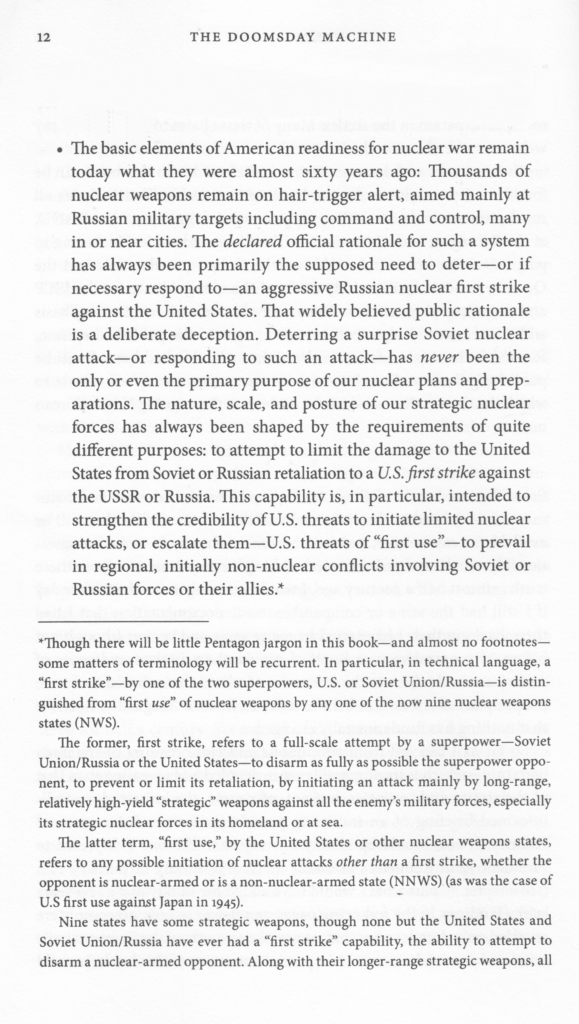
Reading this book is a profoundly difficult experience. Each day I have to step away and think after only reading a limited number of pages.
I will continue to update this Strategic Demands review, and my recollections of Dan, over the course of the next week, as we all begin a new year, one that dawns with hope but with ominous words and actions across the globe.
In North Korea and regions that are connected by entangling alliances, and by consequences of any nuclear war and resulting nuclear winter, we witness political actors gambling with millions of lives and our mutual, shared future.
Dan Ellsberg steps up here, delivering “Confessions of a Nuclear War Planner”. His reality of having been a command and control nuclear expert and being part of a system few are aware exists or thinking how to drawn down the cataclysmic danger this system can deliver at the impulse of one or several men who ‘push a button’, is a message we ignore at our peril.
Looking back at the actions of a Cassandra-like voice is an obligation our generation has, if we are to go forward with rationality.
Perhaps the most frightening element of the Ellsberg warning for today’s generation comes from his knowledge of nuclear war planning.
The “Dead Hand” is real. Attempts to cut off “command and control”, to “behead” the other side, to deliver a “bloody nose” where the grand leader is removed in a “surgical, sudden strike”, all of these can bring on the gambit called “Dead Hand”.
The war plans are in place and the response goes to sequence, automatic sequence that is in place and is ordered in event of loss of command.
Think about the Dead Hand in Korea, think about China’s mutual defense treaties with North Korea, and strategic alliances with the Russian Federation.
Or don’t think — and plunge on as if a nuclear war is no big thing.
An insane policy can be a button on the president’s desk and a president threatening to use his much bigger “Nuclear Button” to deliver — “Fire and fury like the world has never seen“
February 2018: Nuclear Weapons Time, ‘Usable’ Nukes on the Horizon
Time Remembers
Excerpts from occasional SJS social media posts
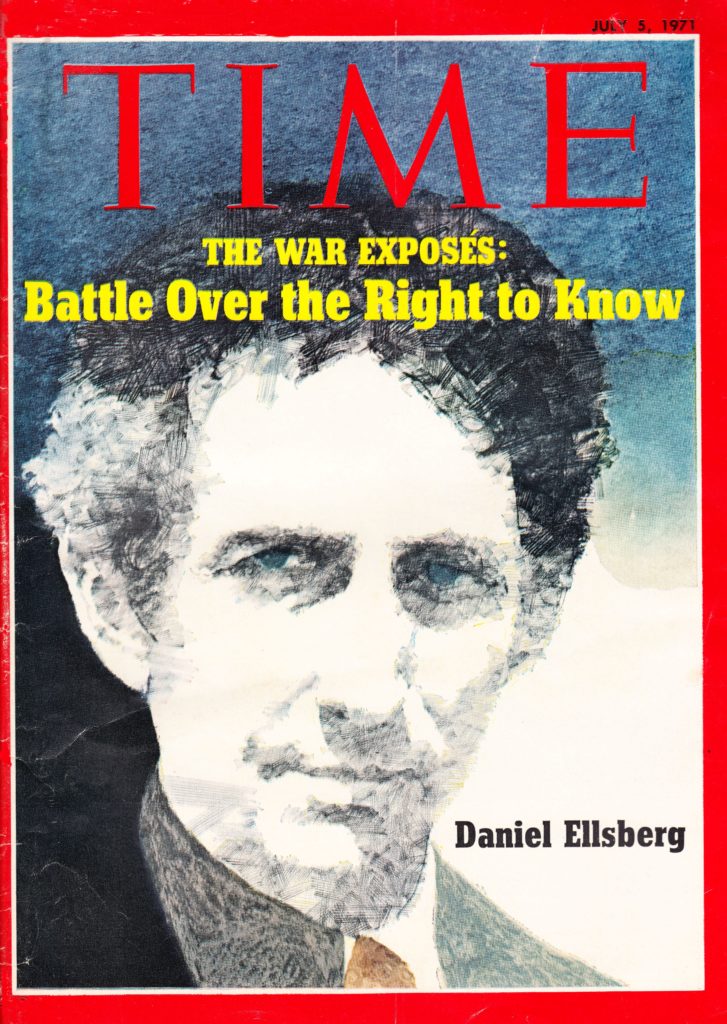
“The Most Dangerous Man in America”
Dan Ellsberg
The Times v The Post and Don’t Forget the Rest of the Press
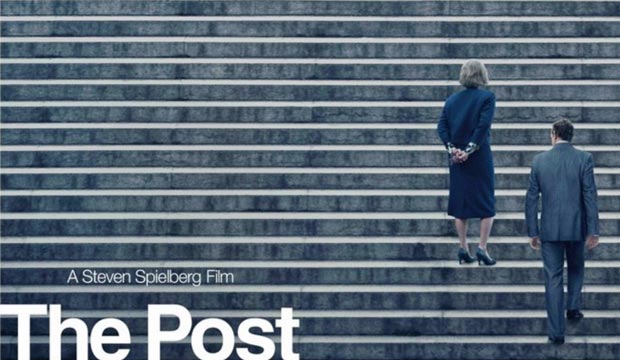
“From the time I was indicted in 1971, after nineteen newspapers had published parts of the Pentagon Papers in the face of four federal injunctions, I was saving the nuclear material for after my trial.”
StratDem Editor:
Dan Ellsberg had the best memory of anyone I knew. Photographic memory. He could have two stacks of documents, pick up one doc from one stack, look at it, memorize it, remember it, days, weeks, months later. He had me test him once, taking a stack of documents at random, then quickly scanning them, page by page, using his hand to move back and forth over pages like an Evelyn Wood course. Then he set the pages down in front of me and said — on any page, say a sentence, I’ll tell you the next sentence. He did.
I think that’s how he was able to read, memorize, sort by subject, and recall the subjects from cable traffic, the operational papers that documented the Vietnam war day to day.
Now, years later, he releases his story of being a nuclear war planner. The Doomsday Machine is a taut, terrifying document of the types of military and political people who make up the nuclear war operation for the U.S.
At the top, is the singular decision-maker, the U.S. president and the chain of command in place to execute decisions to launch should concern, greatly concern, every human on the planet.
Here are some current nuclear use concerns and thoughts of your editor at Strategic Demands in 2017, taken from personal posts and messages published on several social media outlets.
Dan’s Doomsday book is the launch pad for the following dated comments:
- Let’s flashback to Hollywood and a pick up basketball game at Palisades High down the street from the Shearer’s house on Sunset.
Basketball and meet ups w/ a rotating gang of players egged on by the Editor of Parade magazine.
I got to know and became friends w/ guys like David Obst, Jeremy Larner, Dan Ellsberg. Our story this week begins w/ Jeremy and David and only peripherally touches on my time w/ Ellsberg, which we’ll leave aside even as he was getting ready to send out what became known as the Pentagon Papers.
Jeremy wrote a movie, his best, called the Candidate, starring Robert Redford w/ a classic ending: “Son, you’re a politician… what do we do now?”
Redford turned out to be a politician deal-maker in real life, when he was the catalyst in turning Bernstein-Woodward’s Watergate book into a movie. David was the agent and if memory serves me he set up a meeting for the movie. I think the first mtg was originally w/ Jack Valenti.
Anyways, my recollection of David’s story is that the initial book proposal that became the 1974 Simon & Schuster book on how Woodward and Bernstein got at the story of Watergate had one thing missing, acc to screenwriter William Goldman brought in after the Valenti meeting.
It didn’t have a heavy (other than Nixon in the background). Initially the book proposal didn’t have anything about a Deep Throat or the famous line “follow the money”.
The final book manuscript, and the film w/ Hoffman and Redford, revealed the heavy. It was, imo, Goldman’s genius that made it so.
The Goldman touch was always there in his movies. The dramatic tension, good v. bad w/ interludes ala Hitchcock where the clock is ticking, the audience knows it and we want the heroes to get out of there, but they don’t or can’t…
“Who are those guys?” Butch and Sundance wanna know as they attempt to throw the posse off track, and they can’t throw them.
And in the dark DC garage the voice of the Deep character warns them to watch out and guides them to their target, Nixon, who has been protected by his aides and those who are doing the dirty work for him.
Although David believed the heavy was a composite character, until yrs later when Mark Felt came out as Deep Throat and Bernstein-Woodward acknowledged he was. The Heavy existed in the real world. The creative add of Deep into the manuscript and screenplay made the movie.
Even today we find the iconic line “follow the money” works in the current situation in the White House.
Nixon is no Trump, but both have enemies lists. Trump brags about his counter punching, we’re watching it now as he goes after former FBI director Comey, but I’m reminded of what my old friend Jerry Brown says about enemies — ‘try not make too many, because they come back at you.’ The president is still making enemies…
And William Goldman, to my knowledge, has never taken full credit for Deep and Deep’s “follow the money” line even as it continues to resonate day in day out.
We hear the follow the money line now as the president attempts to deal w/ multiple charges.
- Getting older and the old days continue to grow distant. Some, however, are etched in mind and when a reminder crosses my computer screen, I shake my head and think what was I attempting to do?
The time spent with Dan Ellsberg was like that and the time with Allard Lowenstein was like that. Al saw me speaking out against the Vietnam war in 1969 and invited me back to DC to help start up the Vietnam Moratorium, which I did with David Hawk, Sam Brown, Marge and Mixner and a gathering that shaped a strategy to end the war via ‘moratorium’ teach-ins and college/university demonstrations that would reach out to citizens of every walk of life with the story of a war gone profoundly wrong.
I came back to California and the University of Southern California, ‘took over’ the school Religious Center and began organizing throughout the state. I was coordinator and wore many hats. Too many stories to tell here, but the work took me across the state, the country, to Europe and farther.
And one of the folks I met on the road, close to home in Santa Monica, was Dan Ellsberg. He was a source of knowledge for me, a man who was working for McNamara and at the Rand Institute. He was moving from pro-war to opposition as he assembled the history of the war in secret documents that later were to become known as the Pentagon Papers.
I helped him pack the papers at his home in Malibu as he prepared to leave for the East coast and face his future and his fate.
Later, I would meet Roger Morris, who was senior staff on the National Security Council during this period and I began writing with Roger, beginning a long relationship as collaborators.
But it was years before I found out about how close the nation came to the use of nuclear weapons in Vietnam — and the role the Moratorium was said to have in preventing nuclear escalation.
Roger Morris would resign in protest from the Council when the bombing of Cambodia began.
I can only imaging what he, and Dan, and Sy, who I later met and assisted with Dispatch News Service in the syndication of the My Lai story, all felt as they went up again the full force of the US.
I was only a student, even though my roles were pronounced. I was too young, I now realize, to understand how deeply involved I became in events that swept away many in my generation.
Daniel Ellsberg, the Pentagon Papers whistle-blower and a former nuclear war planner, says that bashing Russia is more dangerous than a Trump presidency.
>Excerpted from the link below, Ellsberg’s interviewer wrote: “Ellsberg, who lives in Kensington, did not vote for Trump, whom he regards as a “disaster” in every way but one. “I’m against conflict with Russia, so on this one issue, I’m on Trump’s side. Even if the Russians are guilty of hacking, I don’t think we should risk war with them. Even if the Russians intervened in our election, as we ourselves have done in many countries on an even bigger scale”.”
- I’m thinking about an old friend this morning who I used to play half-court ball against, Jeremy Larner. We were friends and Dan Ellsberg was in our circle and we were going up against big odds back in the days when we looked to stop a war. Jeremy wrote a lot about big odds and one of his favorite bits is in the Candidate — “What do we do now?” (best line in an Academy award winning script) — It’s how I feel this morning after the Paris agr that talks of 1.5 and renewable energy goals that seem out of reach and I read the usual naysayers broadcasting why it can’t be done and the oil/gas lobby is already at work funding the old generation of costly (think ‘full-cost/true-cost of oil/gas’) ways and means
- Remembering Dan, remembering those papers in Malibu, remembering his bravery back when we played basketball on a Pali court and Jeremy Larner, before writing the Candidate, was shooting from the baseline, and David Obst was dribbling then arranging deals and trying to get Sy Hersh’s story out on My Lai when we all hung together doing what we did, and another group that I joined in, and helped start thxs to Al Lowenstein inviting me and others to DC, the Vietnam Moratorium Com’t was growing into what became one of the largest anti war efforts and I’m remembering doing all those anti-war talks in Calif and around the country and Europe, and I recall what it felt like going up against the odds as we were thinking we were patriots… now looking back, it seems a time long gone and far off but it’s not.
- More memories, this time of a moonlit night at Dan Ellsberg’s beachfront place in Malibu, packing up papers that later came to be known as the Pentagon Papers. Brought him a bottle of wine as a bon voyage as he was preparing to leave for Cambridge and his destiny. The Pulitzer today recalls brave souls like Dan who spoke truth to power.
- When Sy Hersh told the story of My Lai, many Americans thought, at first, that this massacre was an aberration. It was not an aberration. It was representative of not only the Vietnam war, My Lai and Vietnam were representative of war, what war is, what war is about. Unlike the Iraq and Afghanistan war, the media was more than “embedded” back then, the press went to the front lines and told the story day in and out. My Lai opened eyes and augered the end of the war but Americans continued supporting this war long after any sane strategic or sound moral reason. War produces a kind of insanity, the rally round the flag patriotism, my country right or wrong.
This new book below, Kill Anything that Moves, is among perhaps twenty to thirty thousand written and published about this war that was started w/ a lie, the Gulf of Tonkin ‘incident’ that conjures up the mistruths of Iraq’s WMDs. This ‘war’ (that was never formally declared and constitutionally voted upon, just like Afghanistan and Iraq) only ended after a millions of deaths in the region… Dan Ellsberg’s Pentagon Papers followed Hersh’s My Lai story and further opened eyes, the history of the war as told by McNamara’s emissary was the so-called “Pentagon Papers”, Ellsberg wanted the people to know, although Robert didn’t anticipate what Dan would do to let people know the truth, after all Dan was a patriot. And I ask, as someone who worked up close back then on both of these truth to power stories, what did Sen McCain learn in his incarceration in N Vietnam?…
Bottom line, some learn, some don’t… for all the reform efforts McCain has made, his ongoing support for bigger wars mystifies me.
http://www.amazon.com/Kill-Anything-That-Moves…/…/0805086919
- Colson, Charles Colson who left this world this past wk… just a few thoughts in reminiscence. On behalf of his boss, Richard Nixon, as eventually came to light at trial, he tried to take out a brave patriot, a friend, Dan Ellsberg, and Colson ended up in prison… his role in assembling the ‘plumbers’ which led to Watergate, his and their attempt to stop the Pentagon Papers and run a melange of dirty tricks to support war policy is the stuff of history bks.
Back then, for those around Ellsberg and others revealing the facts of the war, like Sy Hersh, it was not a light realization to know the gov was out to get you, for opposing the war and letting citizens know the McNamara-commissioned history, which came to be known as the Pentagon Papers, was a trove of Vietnam’s lies told by successive administrations. It was, in a sense, like the multiple deceits leading up to the Iraq war, lies told to justify war policy. One night yrs ago in Malibu at Dan’s house, with loud breaking waves and under an ebbing moon, we packed up boxes of papers. Dan was leaving for the east coast, he was saying good-bye and had a foreboding sense of what he was facing. Later, the Post, Times and Brookings got the papers to publish. Nixon and Kissinger and the others played out their roles and Colson became a minister after getting out of jail. Was their much repentance? Or was it mainly regret that they were discovered? One wonders even as Colson leaves this world as an evangelical…
- Remembering Dan Ellsberg, and long ago a night packing papers in Malibu, as the US Gov officially declassifies the Pentagon Papers today, 40 yrs after the ‘unofficial declassification’ by the NY Times…. here’s to Dan’s profound bravery and taking the truth to the American people…
How I met Dan and began our anti war work… via Lloyd ‘Skip’ Shearer — (In 1970) Kissinger, on a visit to Richard Nixon’s vacation home in San Clemente, summoned Ellsberg’s friend Lloyd Shearer, of Parade, to advise him about the news management of his love life. Shearer brought along Ellsberg, whom Kissinger fobbed off on Alexander Haig so that he could speak privately with Shearer about the ins and outs of dating starlets. But, as Ellsberg was leaving, Kissinger invited him to come back for a talk…
◊
Daniel Ellsberg as Nuclear War Planner now Warns of Nuclear Winter & Global Starvation
Could tension between President Trump and North Korean leader Kim Jong-un bring us to the brink of nuclear war? As tensions ramp up, we discuss what nuclear war would look like with a former nuclear war planner and one of the world’s most famous whistleblowers—Daniel Ellsberg. In 1971, Ellsberg was a high-level defense analyst when he leaked a top-secret report on U.S. involvement in Vietnam to The New York Times and other publications, which came to be known as the Pentagon Papers. He played a key role in ending the Vietnam War. Few know Ellsberg was also a Pentagon and White House consultant who drafted plans for nuclear war. His new book, published Tuesday, is titled “The Doomsday Machine: Confessions of a Nuclear War Planner.” We speak with Ellsberg about his top-secret nuclear studies, his front row seat to the Cuban missile crisis, whether Trump could start a nuclear war and how contemporary whistleblowers Chelsea Manning and Ed Snowden are his heroes.
(StratDem Editor: We are republishing with permission excerpts of the December interview between Dan Ellsberg, Juan Gonzales and Amy Goodman. Now in his 80s, Dan Ellsberg is uniquely prepared to speak to Nuclear Doomsday, security and survival as a strategic “issue of issues”.)
◊
Democracy Now
December 6, 2017
JUAN GONZÁLEZ: North Korea is warning that U.S. actions are bringing the Korean Peninsula to the brink of nuclear war. The warning came Monday as the U.S. and South Korea held massive war games, mobilizing warships, thousands of troops and some 200 U.S. planes, many of them capable of deploying nuclear bombs. North Korea’s Foreign Ministry issued a statement calling President Trump a, quote, “nuclear demon.” Earlier this year, North Korea said it would freeze its nuclear weapons program in exchange for an end to U.S. and South Korean war games, an overture rejected by the Trump administration.
As tensions between the U.S. and North Korea ramp up, today we’re joined for the hour by a nuclear war planner to discuss what nuclear war would look like. He is already well known for another reason, as one of the world’s most famous whistleblowers. In 1971, Daniel Ellsberg was a high-level military analyst when he leaked a top-secret report that detailed the history of U.S. involvement in Vietnam, including a secret dramatic escalation of troops and bombings in what looked like an unwinnable war. He photocopied and shared the 7,000-page document with The New York Times and other publications. The report came to be known as the Pentagon Papers and played a key role in ending the Vietnam War.
AMY GOODMAN: Well, few know that 10 years before, in 1961, Daniel Ellsberg was a consultant with the Pentagon and the the White House, where he drafted plans for nuclear war. In his book, just out this week, titled The Doomsday Machine: Confessions of a Nuclear War Planner, Dan Ellsberg reveals for the first time he also made copies of top-secret documents from his nuclear studies—an entire second set of papers in addition to the Pentagon Papers, for which he is known. Dan Ellsberg is also the author of a 2003 memoir about the Pentagon Papers and Vietnam called Secrets, in which he did not discuss this other set of papers. He’s the subject of the Oscar-nominated documentary The Most Dangerous Man in America. Dan Ellsberg will be a character in the forthcoming Steven Spielberg film about the Pentagon Papers called The Post.
When the come back from our break, we’ll speak with Dan Ellsberg for the hour about nuclear war, the plans he drew up, what nuclear war would look like and his history as the most famous whistleblower in America. Stay with us.
[break]
AMY GOODMAN: “We Will All Go Together When We Go” by Tom Lehrer. This is Democracy Now! I’m Amy Goodman, with Juan González. We’re joined by Dan Ellsberg for the hour, yes, known for leaking the Pentagon Papers in 1971. Today we learn about something else he did over the years, in fact, decades ago: writing up plans for a nuclear war. His book details this, just out this week, The Doomsday Machine: Confessions of a Nuclear War Planner.
So, you made copies of top-secret reports for plans about nuclear war years before you copied the Pentagon Papers—
DANIEL ELLSBERG: That’s right.
AMY GOODMAN: —and released them to the press?
DANIEL ELLSBERG: Essentially, my notes, and sometimes verbatim excerpts, not the entire plans themselves, but on plans that were then unknown to the president, to begin with, to President Kennedy. I briefed his aide, McGeorge Bundy, in his first month in office on the nature of the plans and some of the other problems, like the delegation of authority to theater commanders for nuclear war by President Eisenhower, which was fairly shocking to McGeorge Bundy, even though Kennedy chose to renew that delegation, as other presidents have.
But I was given the job of improving the Eisenhower plans, which was not a very high bar, actually, at that time, because they were, on their face, the worst plans in the history of warfare. A number of people who saw them, but very few civilians ever got a look at them. In fact, the joint chiefs couldn’t really get the targets out of General LeMay at the Strategic Air Command.
And there was a good reason for that: They were insane. They called for first-strike plans, which was by order of President Eisenhower. He didn’t want any plan for limited war of any kind with the Soviet Union, under any circumstances, because that would enable the Army to ask for enormous numbers of divisions or even tactical nuclear weapons to deal with the Soviets. So he required that the only plan for fighting Soviets, under any circumstances, such as an encounter in the Berlin corridor, the access to West Berlin, or over Iran, which was already a flashpoint at that point, or Yugoslavia, if they had gone in—however the war started—with an uprising in East Germany, for example—however it got started, Eisenhower’s directed plan was for all-out war, in a first initiation of nuclear war, assuming the Soviets had not used nuclear weapons.
And that plan called, in our first strike, for hitting every city—actually, every town over 25,000—in the USSR and every city in China. A war with Russia would inevitably involve immediate attacks on every city in China. In the course of doing this—pardon me—there were no reserves. Everything was to be thrown as soon as it was available—it was a vast trucking operation of thermonuclear weapons—over to the USSR, but not only the USSR. The captive nations, the East Europe satellites in the Warsaw Pact, were to be hit in their air defenses, which were all near cities, their transport points, their communications of any kind. So they were to be annihilated, as well.
I couldn’t believe, when I saw these, that the joint chiefs actually had ever calculated how many people they would actually kill in this course. In fact, colonels who were friends of mine in the Air Staff told me they had never seen an actual figure for the total casualties. We had exact figures of the number of targets and how many planes would be needed and every sort of thing, many calculations. But not victims.
So, I drafted a question, which the aide to McGeorge Bundy, Bob Komer, sent to the joint chiefs in the name of the president. And the question was: In the event of your carrying out your general nuclear war plans, which were first-strike plans, how many will die? First I asked, in the USSR and China alone, in the thought that, by the way, they’d be embarrassed to discover—to say, “We have to have more time. We’ve never really calculated that.” I was wrong. And my friends were wrong in the Air Force. They came back with an answer very quickly: 325 million people in the USSR and China alone.
Well, then I asked, “All right, how many altogether?” And a few days later, 100 million in East Europe, the captive nations, another 100 million in West Europe, our allies, from our own strikes, by fallout, depending on which way the wind blew, and, however the wind blew, a third 100 million in adjoining countries, neutral countries, like Austria and Finland, or Afghanistan then, Japan, northern India and so forth—a total of 600 million people. That was a time, by the way, when the population of the world was 3 billion. And that was an underestimate of their casualties—a hundred Holocausts.
It was very clear that they hadn’t included—I hadn’t asked, actually, what would Russian retaliation be against us and against West Europe. They were thought, at that time—wrongly—to have hundreds of weapons against the U.S. But they did have hundreds of weapons against West Europe, no question. West Europe would go, under any circumstances. If we were defending West Europe—Germany, for example—we were planning to destroy the continent in order to save it.
Six hundred million, that was a hundred Holocausts. And when I held the piece of paper in my hand that had that figure, that they had sent out unembarrassedly, you know, proudly, to the president—”Here’s what we will do”—I thought, “This is the most evil plan that has ever existed. It’s insane.” The weapons, the machinery that will carry this out, this was no hypothetical plan, like Herman Kahn might have conceived at the doomsday machine that he thought up at the RAND Corporation as my colleague. This was an actual war plan for how we would use the existing weapons, many of which I had seen already that time.
JUAN GONZÁLEZ: Dan Ellsberg, the colossal carnage that they were envisioning as a result of this first-strike use was doubly—made doubly worse, as you reveal, by the fact that the image that we have that the president is the one who holds the switch or has his hand on the button is not true, that many people have the capacity to initiate a nuclear war. If you could you talk about that, as well?
DANIEL ELLSBERG: To start with, even if it were only the president, no one man—really, no one nation—should have the ability—the ability even—to threaten or to carry out a hundred Holocausts at his will. That machinery should never have existed. And it does exist right now, and every president has had that power, and this president does have that power.
But the recent discussions of that, which emphasize his sole authority to do that, don’t take account of the fact that he has authority to delegate. And he has delegated. Every president has delegated. I don’t know the details of what President Trump has done or since the Cold War. Every president in the Cold War, right through Carter and Reagan, had delegated, in fact, to theater commanders in case communications were cut off. That means that the idea that the president is the only one with sole power to issue an order that will be recognized as an authentic authorized order is totally false.
How many fingers are on buttons? Probably no president has ever really known the details of that. I knew, in ’61, for example, that Admiral Harry D. Felt in CINCPAC, commander-in-chief of Pacific, for whom I worked as a researcher, had delegated that to 7th Fleet, down to various commanders, and they, in turn, had delegated down to people. So when you say, “How many altogether feel authorized?” if their communications are cut off—and that happened part of every day in the Pacific when I was there—communications got better, but the delegations never changed. There’s—we’ve never allowed it to be possible that an enemy could paralyze our retaliation by hitting our president or our command and control.
And neither did the Russians. When President Carter and then President Reagan advertised the fact that their plans emphasized decapitation, hitting Moscow, above all, which the French and British always planned to do, by the way, with their smaller forces—and when that became clear, the Russians instituted what they called a dead hand, a perimeter system, in Russian, which assured that if Moscow was destroyed, other commanders would have the power and would be told to launch their strikes.
There was even a plan to do that automatically by computer, as a number of our military always recommended, to make the whole thing computerized, as in the doomsday machine of Herman Kahn and Stanley Kubrick. But, generally, they allow for lower-level majors, colonels to decide, “The time has come. We’ve lost our commanders. The time has come to go.” That’s almost certainly true in North Korea right now.
AMY GOODMAN: So, when you heard about President Trump having that meeting with the joint chiefs of staff in the summertime, the one where allegedly—I mean, Rex Tillerson has not confirmed or denied this—he called the president an “F—ing moron,” that apparently was in response to Trump asking three times in that meeting, “If we have nuclear weapons, why don’t we use them?”
DANIEL ELLSBERG: Well, he had asked that, allegedly, according to Joe Scarborough and others, to people during the campaign a year earlier. And an answer to that, of course, is he will use them.
And he is using them right now. It’s not a question of whether the president might use them. He’s using them the way you use a gun when you point it at somebody in a confrontation, whether or not you pull the trigger. And both Trump and Kim are using their weapons in that encounter right now, as many presidents have done, as I discovered later—as there’s a chapter in the book of a couple dozen, perhaps three dozen cases, mostly in secret, where presidents have actually pointed the gun, aside from wearing it ostentatiously on their hip at all times, as in NATO. I think the—one of our commanders just said, “Oh, we use the weapons every day, every hour of the day,” which is true. We use them on the hip.
But at the moment, they’re being pointed. And they’re being pointed by two people who are giving very good imitations of being crazy. That’s dangerous. I hope they’re pretending. They might be pretending. But to pretend to be crazy with nuclear weapons is not a safe game. It’s a game of chicken. Nuclear chicken.
Watch the interview online at Democracy Now
DANIEL ELLSBERG: I listened to the president on October 22nd, I remember, announcing that there were missiles in Cuba, and I called up my friend, Deputy Assistant Secretary of Defense Harry Rowen, later president of RAND, and asked, “Do you need some help out there?” And he said, “Get on the next plane,” which I did.
I flew out to Washington, then, the next morning, early, got into the Pentagon, the day, actually, that the blockade was instituted—no, the day before, actually—and was given the task, for example, since I was a command-and-control specialist, of—that’s how I got into nuclear planning—what can the Russians do with 30-some missiles on Cuba? Well, they can hit Moscow—I’m sorry, they can hit Washington. They can hit Washington, which is what our joint chiefs would do. And they could hit various other places. And that, I knew, would not paralyze our response. It would only make it quickly carried out against all the cities in Russia and China and so forth. It would do them no good, but that’s probably what they would do, and so forth.
I worked during that week. Some nights I slept in the office of president—of, sorry, Assistant Secretary of Defense Paul Nitze, and on a couch in his office, while we were—I was on several task forces, working for the Executive Committee, EXCOMM, of the National Security Council. Now, the next year I spent studying a great deal on that crisis, with higher than top-secret access, on the whole. And yet, I didn’t learn many of the things that are most important about that crisis, which have taken decades and decades to come out of secrecy.
For one thing, I’ve concluded, contrary to what I thought at the time, that both President Kennedy and Nikita Khrushchev were determined not to carry out the threats they were making of armed conflict—compared to the North Korean crisis right now. Imagine that both sides have decided they are absolutely not going to armed conflict, they’re only gesturing and breast-beating and trying to get the other side of back down. That’s what was happening in the Cuban missile crisis. And yet, to make the threats credible, Khrushchev was maneuvering submarines within the range of our forces, armed with nuclear torpedoes we didn’t know they had at all. And they were subject to mock depth charges to bring them to the surface, with our Navy not knowing that they were facing submarines that could blow them all out of the water. Kennedy, on the other hand, was moving troops, exactly like those exercises. As a matter of fact, we had done exercises, just before the crisis broke, of invading Cuba—not named Cuba. The enemy they were against was announced in the papers as Ortsac, which, as Khrushchev inferred, cleverly, was Castro spelled backwards, said, “Yes, that was a game we used to play when I was a kid,” said Khrushchev.
So, here we were threatening to invade Cuba. It was not a way to keep the Cubans from acquiring a deterrent force, just as our exercises of invading North Korea, going on right now, essentially, don’t seem a very well-chosen way to get Kim Jong-un to give up his deterrent capability in the—in North Korea. But that’s what we were doing.
JUAN GONZÁLEZ: But you say in the book also—
DANIEL ELLSBERG: The other thing I learned was that in the course of these maneuvers, we came within a hair’s breadth of blowing the world up, of having the plans I’ve just described go into action. A nuclear submarine—I should say, a submarine that was armed with nuclear torpedoes had the two top commanders, who thought they were being—going to go down, actually, as a result of these mock depth charges that were actually meant to force them to the surface. The commander, Savitsky, ordered the nuclear torpedo armed and ready for action against the destroyers or the cruiser. The second-in-command, whose assent was needed, agreed with him. And they were ready to go.
It happened that a commodore of several submarines in the area was on that sub rather than some other one. It could have been one of the others, but he was there. And since he was the commodore, his assent was also needed. And he said no. And thanks to that man, Vasili Arkhipov, we didn’t blow a cruiser out of the water and cause the nuclear explosion that Kennedy had already announced would cause an all-out attack on the Soviet Union. That’s why we’re still here.
Watch the complete interview online at Democracy Now
JUAN GONZÁLEZ: Well, we’re spending the hour with Daniel Ellsberg, who leaked the Pentagon Papers in 1971. His new book is The Doomsday Machine: Confessions of a Nuclear War Planner. Ellsberg reveals he also made copies of top-secret reports on plans for nuclear war. I want to turn to a clip from the film Dr. Strangelove or: How I Learned to Stop Worrying and Love the Bomb, directed by Stanley Kubrick. Ellsberg has joked that it could be a documentary. The black comedy was released in 1964, just two years after the Cuban missile crisis.
AMY GOODMAN: The film centers on a nuclear crisis that begins when a U.S. bomber plane loaded with nuclear weapons is on a routine flight pattern near the Soviet Union at the time when it receives orders to carry out “Wing Attack Plan R.” That’s nuclear war, from lunatic General Jack D. Ripper, using the pre-delegated authority given to him in case of an attack on Washington. Much of the film takes place in the War Room, where the president meets his top Pentagon advisers, who want to proceed with the attack despite his hesitation. They hit a snag when the Soviet ambassador informs them of Russia’s new weapon: a doomsday machine that will destroy the entire world if they’re attacked. So, in this scene from the film, we’re in the War Room when the president’s adviser, Dr. Strangelove, is asked to describe the doomsday machine, based on a study he commissioned from the so-called BLAND Corporation.
PRESIDENT MERKIN MUFFLEY: [played by Peter Sellers] But, how is it possible for this thing to be triggered automatically, and at the same time impossible to untrigger?
DR. STRANGELOVE: [played by Peter Sellers] Mr. President, it is not only possible, it is essential. That is the whole idea of this machine, you know. Deterrence is the art of producing in the mind of the enemy the fear to attack. And so, because of the automated and irrevocable decision-making process which rules out human meddling, the doomsday machine is terrifying, as is simple to understand, and completely credible and convincing.
GEN. ”BUCK” TURGIDSON: [played by George C. Scott] Gee, I wish we had one of them doomsday machines.
AMY GOODMAN: That’s a clip from the 1964 film Dr. Strangelove about the doomsday machine, which is also the title of our guest Daniel Ellsberg’s new book, The Doomsday Machine: Confessions of a Nuclear War Planner. Your colleague at the BLAND Corp—I mean, the RAND Corporation is the one who coined that term?
DANIEL ELLSBERG: Herman Kahn invented that idea. And he said, by the way, that it kills so many people—everyone, actually—that no one ever would produce such a machine. He said it doesn’t exist, and it never would exist. He said that in 1959 and ’60. He was wrong. It did exist at that time, and it’s existed ever since. We didn’t know that for another 20 years. We didn’t know that the weapons we had targeted on all these cities—and, by the way, I tried to change that under Secretary McNamara. I said, “Have a withhold option against all the cities here. You know, why are you killing the cities here in—either in retaliation or, least of all, in a first strike? Which would force them or, you know, which would cause them, certainly, to hit our cities inevitably, which they probably will do anyway. But this gives them no incentive to refrain from our cities, whatever. Why are we hitting Moscow? How do you possibly ever get the war stopped? How can you possibly get it limited? How could they surrender or the war end in any way, if you’ve hit their central command?” And that seemed to make some sense, and there was a withhold option against that—never implemented. When Cheney came in, years later, he was amazed to discover how many weapons were still targeted on Moscow. And we’re talking about hundreds here, which seemed crazy to me.
Anyway, the system, however, as I’ve already said, they knew—they did plan that they were going to kill—I said 600 million, but actually they weren’t including the effects of fire. They never have, because it’s too incalculable in the weather and the inflammable materials and so forth. Actually, that’s the biggest effect of thermonuclear weapons. So the number would really have been, at that time, well over a billion, plus the Soviet retaliation against Europe. So we’re talking about over a billion people, a third of the Earth’s population at that time. And I’ve actually heard Edward Teller, one of the sources of Dr. Strangelove, the fictional Dr. Strangelove, the father of the H-bomb, Teller, say, “At most, thermonuclear weapons could cause the deaths of one-third of the population,” very close to what the joint chiefs had said. I thought of that as the glass two-thirds full, when I heard him say that. But the fact is, he was wrong. And Kahn was wrong. Nobody’s perfect. In fact, it would be three-thirds.
The fact is that the weapons on these cities, which continued always, despite the supposed withholding option, to be targeted on military targets in the cities—the cities would burn nevertheless. And not only would there be fire, that were not in the calculations, there would be smoke, surprise. And the firestorms that would be caused by these simultaneous widespread fires, as in the Tokyo firestorm of March 9th and 10th, 1945—there were only three so-called firestorms in World War II—Hamburg, Dresden and Tokyo—where the fires were so widespread that they caused a column of air to rise abruptly very high into the stratosphere. And what had not been calculated before, ’til 1983, was that the millions and millions, possibly 100 million, tons of smoke and black soot would be lofted into the stratosphere, where it would not be rained out ever, and it would spread quickly around the world, causing a blanket that would destroy—or, rather, absorb—most of the sunlight from reaching the Earth, 70 percent of the sunlight, killing all the harvests worldwide and preventing any vegetation, starving everyone on Earth, essentially—nearly everyone, let me correct that. Carl Sagan, when he first was reporting this in 1983, more than a third of a century ago, said extinction was possible. The latest calculations show, no, extinction is very unlikely. We’re so adaptable, we can live in the tip of New Zealand eating mollusks, some millions of people. But 98 or 99 percent of the people will go near extinction—close enough to be called a doomsday machine.
And that is what both U.S. and Russia have still on hair triggers, with the delegation, with launch on warning, with ICBMs on both sides that are vulnerable to attack by the other, and therefore have the incentive to use them or lose them if there’s warning of an attack on the way. Now, false warnings have occurred on both sides repeatedly and gone into several minutes. In 1995, years after the—seven years after the Cold War was over, Premier Yeltsin—for the first time, either side—was shown his briefcase and the buttons that he would push to launch nuclear war, because of what was in fact a Norwegian weather rocket that was mistaken for a rocket that might be headed at Moscow for decapitation. And he hesitated, Yeltsin, at that time, long enough that the missile would have arrived. And they decided it was a false alarm. If he had not, we wouldn’t be here, because the nuclear winter resulting from the attack on one side, or both, would have produced smoke that long ago would have starved us and nearly everyone else on Earth.
Watch the interview online at Democracy Now
JUAN GONZÁLEZ: So, when you hear the news accounts now of the threats of North Korea and the response of the president, that he will rain fire and fury on the Korean Peninsula, what’s your reaction to the nature of the debate now? Because I would think that back in the ’80s the public consciousness of nuclear winter, of the dangers of nuclear weapons, seemed a lot greater throughout the United States than it is today.
DANIEL ELLSBERG: Well, these are the first threats that any American president—and American presidents have made many nuclear threats, as we said earlier, in the past. These were the first ones since the Cuban missile crisis, more than half a century ago, against a nuclear weapon state. Harry Truman made nuclear threats 67 years ago against North Korea, but North Korea wasn’t a nuclear state then. And by the way, we didn’t need nuclear weapons to bring fire and fury like the world had never seen, except in Tokyo and Dresden and Hamburg. We burned North Korea to the ground without using nuclear weapons at that time, left not a stick of man-made structure left standing in North Korea. So they all remember that if they’re President Trump’s age or older, actually. He was four at the time. But that was indelible memory. They can believe we would do that.
But now they have nuclear weapons. If they were smart, they wouldn’t send them back at us, because that would be sheer suicide for them. Every man, woman and child in North Korea, as he’s implied, would be killed. Should we count that they won’t do that, that they won’t retaliate to our strike? No. He’s not going to take his nuclear weapons entirely out of Korea as we have these exercises. He thinks he would be crazy to do that. It would be suicidal. And that’s not the kind of crazy he is. The kind he is is the kind we are, which is nuclear weapons are to be met, or even preempted, with nuclear weapons, that striking first is better than striking second, and striking second is better than not striking at all. It’s crazy, but we’ve shown that kind of craziness for 70 years…
A world’s worth of lives are at stake here. And I would say, do what I wish I had done in ’61, which is put out those documents then, or in ’64, before the Pentagon war actually got started in a big way. Don’t wait. As Martin Luther King says, there is such a thing as too late. And he talked of the fierce urgency of now.
This crisis right now may awaken people in the Pentagon and in the public to the dangers we’ve been living with secretly for so long…
AMY GOODMAN: We have to leave it there. Dan Ellsberg, thanks so much for being with us. His new book, The Doomsday Machine: Confessions of a Nuclear War Planner, Ellsberg revealing he also made copies of top-secret reports on plans for nuclear war.
Reprinted under Creative Commons Attribution-Noncommercial-No Derivative Works 3.0 United States License.
◊
“The Battle Over the Right to Know”
A Life Journey
